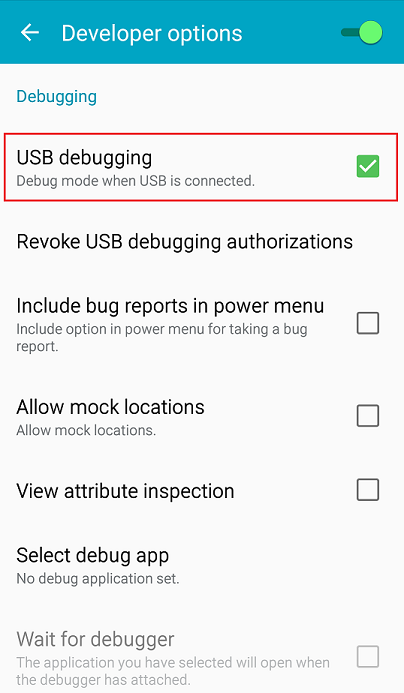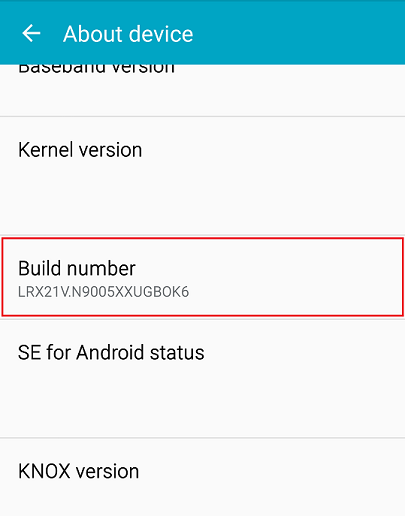- Unity User Manual (2018.2)
- Indicaciones Específicas de Plataforma
- Android
- Empezar con el desarrollo de Android
- Android environment setup
Android environment setup
Whether you’re building an Android application in Unity or programming it from scratch, you must set up the Android Software Development Kit (SDK) before you can build and run any code on your Android device.
1. Install the Java Development Kit
Download and install the Java Development Kit (JDK). Unity requires the 64-bit version JDK 8 (1.8).
2. Download the Android SDK
You can install the Android SDK using command line tools or through Android Studio. Android Studio provides an easy to use GUI based tool, but installs additional software on your computer. Using the command line tools is a smaller download and does not install additional software, but it can be more challenging to use.
2a. Install the Android SDK using the command line tools
Install or unpack the Android SDK. After installing, open the Android SDK Manager and add: at least one Android SDK Platform, the Platform Tools, the Build Tools, and the USB drivers if you’re using Windows.
To install an Android platform SDK and the associated tools:
Download the Android Software command line tool.
Unzip the tools folder to a location on your hard drive.
Open a command-prompt window.
Navigate to the bin folder in the location where you unzipped the tools folder: “install folder” > tools > bin
-
Use the sdkmanager command line tool to retrieve the list of packages that you can install. The installable packages include the Platform SDKs, Build Tools, Platform tools, and other tools.
sdkmanager –list
-
Select a version of the Platform SDK to install. Platform SDKs take the following form in the list: platforms;android-xx. The xx indicates the SDK level. The larger the number, the newer the package. Typically, you can install the latest available version. But, there might be cases in which Google has released a new version of the SDK that causes errors when you build your Unity Project. In that case you must uninstall the SDK and install an earlier version. The general format of the command for package installation is sdkmanager <package name>. You can install the corresponding Platform Tools and Build Tools at the same time.
Example: sdkmanager “platform-tools” “platforms;android–27” “build-tools;27.0.3”
-
If you are running on Windows, install the USB device drivers.
sdkmanager “extras;google;usb_driver”
This installs the SDK in a directory named “platforms” in the directory in which you unzipped the tools folder. Example: c:\<install folder>\platforms
2b. Install the SDK using Android Studio
Install Android studio from the Android developer portal. The Android developer portal provides detailed installation instructions.
Note: Android Studio provides some ease of use benefits, but it is not fully tested for compatibility with Unity installs. If you encounter errors, Unity recommends using the command line method.
When installing the Android platform SDK and other tools, you can typically install the latest available version. There might be cases in which Google has released a new version of the SDK that causes errors when you build your Unity Project. In that case you must uninstall the SDK and install an earlier version.
Install the associated Platform and Build tools at the same time. If you are running on Windows, install the USB device drivers.
3. Habilite la depuración USB en su dispositivo
To enable USB debugging, you must enable Developer options on your device. To do this, find the build number in your device’s Settings menu. The location of the build number varies between devices. The stock Android setting can be found by navigating to Settings > About phone > Build number. For specific information on your device and Android version, refer to your hardware manufacturer.

Note: On Android versions prior to 4.2 (Jelly Bean), the Developer options aren’t hidden. Go to Settings > Developer options, then enable USB debugging.
After you navigate to the build number using the instructions above, tap on the build number seven times. A pop-up notification saying “You are now X steps away from being a developer” appears, with “X” being a number that counts down with every additional tap. On the seventh tap, Developer options are unlocked.
Connect your device to your computer using a USB cable. If you are developing on a Windows computer, you might need to install the a device specific USB driver. See the manufacture web site for your device for additional information.
The setup process differs for Windows and macOS, and is explained in detail on the Android developer website. For more information on connecting your Android device to the SDK, refer to the Running Your App section of the Android Developer documentation.
Go to Settings > Developer options, and check the USB debugging checkbox to enable debug mode when the device is connected to a computer via USB.

4. Configure the Android SDK path in Unity
The first time you create a Project for Android (or if Unity later fails to locate the SDK), Unity asks you to locate the folder in which you installed the Android SDK.
If you installed the SDK using the sdkmanager, you can find the folder in <android tools install location>\platforms\<android sdk folder>.
Ejemplo:
c:\<android tools install location>\platforms\android–27
If you installed the SDK when you installed Android Studio, you can find the location in the Android Studio SDK Manager. To open the SDK Manager from Android Studio, click Tools > Android > SDK Manager or click SDK Manager in the toolbar.

To change the location of the Android SDK, in the menu bar go to Unity > Preferences > External Tools.
5. Download and set up the Android NDK
If you are using the IL2CPP scripting backend for Android, you need the Android Native Development Kit (NDK). It contains the toolchains (such as compiler and linker) needed to build the necessary libraries, and finally produce the output package (APK). If you are not targeting the IL2CPP back end, you can skip this step.
Download Android NDK version r13b (64-bit) from the NDK Downloads web page. Extract the android-ndk folder to a directory on your computer and note the location.
The first time you build a Project for Android using IL2CPP, you are asked to locate the folder in which you installed the Android NDK. Select the root folder of your NDK installation. To change the location of the Android NDK, in the Unity Editor, navigate to the menu: Unity > Preferences to display the Unity Preferences dialog box. Here, click External Tools.